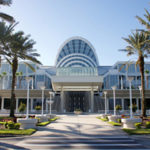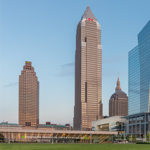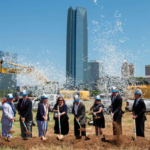Once again Bill Wallace, the hotel’s director of sales and marketing, did most of the talking, but this time he had an actual building to show off, and he led our group on an enthusiastic march to the top of its 12 floors of guest and conference rooms and then down through its four underground levels of meeting and event space.
It’s an impressive feat of engineering — a boxy collection of glass and metal, LEED Silver-certified, the largest hotel in Washington, D.C., with 1,126 guest rooms, 105,000 square feet of meeting space, including the 30,600-square-foot Marquis Ballroom and more than 54 breakout rooms, all tucked onto a footprint of just more than three acres, right across the street from the Walter E. Washington Convention Center. But the Marriott Marquis also has a sense of intimacy that in some ways belies its gracefully imposing physical presence. Here’s how that manifested itself during the tour:
 It’s a part of the city. The bone-white floor of the lobby is riven with shoots and stalks of dark tile meant to suggest the branches of Washington’s famous cherry-blossom trees. Meeting rooms are named after D.C. universities (Georgetown, Howard, Catholic, etc.), neighborhoods (Dupont Circle, Adams Morgan, Anacostia, etc.), and buildings (Treasury, Archives, Capitol, etc.). On the 12th floor, the M Club Lounge offers an outdoor patio with seating for up to 81 people along with panoramic views of the city — not so much the monuments and museums that tourists visit as the offices and parks and apartments where residents live their lives. Inside and out, this is a hotel that seems to love its destination, and to encourage its guests to engage with it fully.
It’s a part of the city. The bone-white floor of the lobby is riven with shoots and stalks of dark tile meant to suggest the branches of Washington’s famous cherry-blossom trees. Meeting rooms are named after D.C. universities (Georgetown, Howard, Catholic, etc.), neighborhoods (Dupont Circle, Adams Morgan, Anacostia, etc.), and buildings (Treasury, Archives, Capitol, etc.). On the 12th floor, the M Club Lounge offers an outdoor patio with seating for up to 81 people along with panoramic views of the city — not so much the monuments and museums that tourists visit as the offices and parks and apartments where residents live their lives. Inside and out, this is a hotel that seems to love its destination, and to encourage its guests to engage with it fully.
It invites you in. The photo at the top of this post doesn’t just show “The Birth of the American Flag,” the custom, 56-foot-high, steel sculpture in the dead center of the hotel’s atrium. It shows “The Birth of the American Flag” from inside the soaring, 27,000-pound structure — I was surrounded by its three flowing support struts, pointing my phone straight up, when I took the picture. The sculpture is the first thing you see when you come in the front door; it draws you immediately toward it, and anyone who wants to can walk up to and around and underneath it. How’s that for encouraging you to feel right at home?
 It honors its past. In 1927, J. Willard Marriott and his wife, Alice, opened a root-beer stand in Washington, D.C. They grew that into the Hot Shoppes family-restaurant chain, with branches throughout the D.C. metropolitan area, and gradually moved into hotels. The last Hot Shoppes location closed in 1999, but the Marriott Marquis’ Anthem restaurant, open for breakfast and lunch, includes a nine-stool Hot Shoppes-style counter that offers some of the chain’s favorites, including the Mighty Mo burger and the Orange Freeze milkshake. Simple nostalgia, maybe, but it fosters an emotional connection between the property, its founding father, and the destination where his company is still headquartered.
It honors its past. In 1927, J. Willard Marriott and his wife, Alice, opened a root-beer stand in Washington, D.C. They grew that into the Hot Shoppes family-restaurant chain, with branches throughout the D.C. metropolitan area, and gradually moved into hotels. The last Hot Shoppes location closed in 1999, but the Marriott Marquis’ Anthem restaurant, open for breakfast and lunch, includes a nine-stool Hot Shoppes-style counter that offers some of the chain’s favorites, including the Mighty Mo burger and the Orange Freeze milkshake. Simple nostalgia, maybe, but it fosters an emotional connection between the property, its founding father, and the destination where his company is still headquartered.
It’s made of light. That’s being a little poetic, but seriously — during the day, the atrium is flooded with sunlight that seems to spill into every corner of the property, even interior rooms. And thanks to two large cutouts opening up the lobby floor on either side of the main entrance, light splashes down into the first two levels of the Marriott Marquis’ underground meeting space,allowing the hotel to install natural plants throughout those prefunction areas. The building is burrowed 110 feet below ground, but still manages to offer about the least subterranean-feeling conference facility I’ve seen.
Of course, they’ve had years and years to work all that out. The Marriott Marquis, Washington, DC has been a long time coming, and having toured the entire property, and stood on the 12th-floor patio, and lingered next to the gleaming rise of “The Birth of the American Flag” — I’d say the stops and the starts and the false hopes and the many frustrations were worth it. As Bill Wallace put it: “We’re trying to move on from that.”



